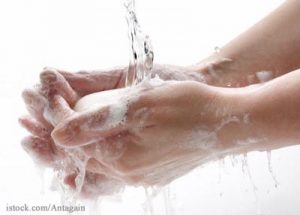Most food poisoning cases happen in the home. Why? Research from Kansas State University finds that 90% of home chefs violate food safety rules, especially rules about hand washing and cross-contamination. Cross-contamiantion happens when hands are not washed after handling raw meats, when cutting boards and utensils are used for fresh foods after coming into contact with raw meats, and when preparing food.
 The study was conducted to discover which type of food safety education resulted in the best food safety practices. One hundred twenty three participants were divided into three groups. The first group was told about the food safety campaign messages of “clean, separate, cook, and chill.” The second group looked at pubic service announcements on this message, and the third did not have any training.
The study was conducted to discover which type of food safety education resulted in the best food safety practices. One hundred twenty three participants were divided into three groups. The first group was told about the food safety campaign messages of “clean, separate, cook, and chill.” The second group looked at pubic service announcements on this message, and the third did not have any training.
Researchers taped participants preparing a meal using raw meat and a ready-to-eat fruit salad. The meat was inoculated with a nonpathogenic bacteria in order to trace possible cross-contamination. The study found that 90% of the participants contaminated the salad.
Everyone made mistakes that could lead to foodborne illness. Most tracked bacteria all over the kitchen, such as on countertops, faucets, handles, and wastebaskets. the worst contamination was found on hand towels. The group that was told about the food safety messages did slightly better than the group who received no training, but the differences were not striking.
Randy Phebus, professor of food safety at Kansas State University and one of the authors of the study said, “we found that most people tried to wash their hands, but did it very ineffectively – either only using water or not washing for long enough. By not washing their hands correctly, they spread contamination to the hand towels. They then go back to those towels multiple times and recontaminate themselves or the kitchen surfaces with those towels. It ultimately leads to contamination in the food product.”
To properly wash your hands, the CDC recommends these steps. Wet your hands with clean, running water, turn off the tap, and add soap. Lather your hands, making sure to get the soap on the backs of your hands, between your fingers, and under your nails. Scrub hands for at least 20 seconds. Rinse well under clean, running water, and dry using a clean towel. A hand sanitizer containing at leaf 60% alcohol is the second best method, but are not as effective as soap and water, especially when hands are dirty or greasy. Surfactants in soap lift soil and bacteria from the skin.





I had no idea how dangerous it is not to wash my hands after i touch meat! I usually just water them and wipe them but not really wash them. I will definitelly do from now on! Thanks for the post! Really useful information! Greetings, Monken Hadley Carpet Cleaners Ltd.
Their website says “Turning off the faucet after wetting hands saves water, and there are few data to prove whether significant numbers of germs are transferred between hands and the faucet.”
Thank you Brenda!
The CDC says: wet hands, turn off tap, add soap. (Gee whiz, the tap is now contaminated with pathogens). Wash hands, then turn on tap to rinse, then turn off dirty tap with clean hands and re-contaminate them. Not good. I turn on the tap with my arm, wet hands and leave water running while I soap, rinse, soap and rinse. (I don’t use a bar of soap, I use liquid soap made from my bar soap, in a pump dispenser). Then turn off the tap. My hands are clean with no re-contamination. No wonder people are not too trusting of anything the CDC tells us. LOL
Good points! Although I trust the CDC. I also use liquid soap instead of bar soap. I did wonder why they said to turn off the water. And I always use paper towel, not a hand towel.